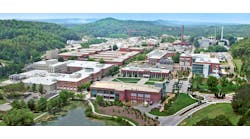Climate Risk Sharpens Focus on Energy Security, On-Site Power Generation
This week the American West resembles an apocalypse, with raging wildfires consuming thousands of acres of parched landscape, turning daytime skies a hazy orange and leaving death and destruction in their wake. Many West Coast residents are at imminent peril for their life or property, while others must manage rolling power blackouts to protect utility grids.
The West Coast wildfires offer a dramatic example of how climate change is altering weather patterns and disaster risk. Data center operators, who have spent years working to improve energy efficiency and renewable power to head off climate damage, must now adapt to the real-time challenges of a changed environment.
That includes a greater focus on energy security. Data centers rely on uninterrupted power to keep mission-critical operations online around the clock, serving as a lifeline to the world during the COVID-19 pandemic. The predictably of utility power is being tested by the wildfires, which are forcing extraordinary power conservation efforts in California, including emergency shutoffs.
In our annual forecast (Eight Trends That Will Shape the Data Center in 2020) we made two related predictions on energy – that climate risk would prompt more adoption of on-site power generation, and large investors would look to integrate green power into data center campuses. This is showing up in at least three strategies.
- Climate risk, along with the growing complexity of global energy delivery, will prompt more data center operators to integrate on-site generation or pursue other strategies beyond traditional utility power.
- Some of the largest financial players in the data center sector are stepping up their investment in energy, and looking for opportunities to integrate more renewable energy sources into their power mix. Global operator NTT and infrastructure funds Macquarie and Stonepeak are among those hoping to deploy new power generation infrastructure to support their data center footprints.
- As some operators build for a more secure and sustainable energy future, others are prioritizing energy security in their site selection decisions, accelerating the migrations out of markets with climate or energy risks that pose a threat to reliability.
The combination of climate risks, capacity challenges, and access to renewables is prompting more providers to “think outside the grid.” Here’s a deeper look at this challenge.
‘Turn On Your Generators!’
On the afternoon of August 18, California declared a power emergency, as a heat wave stressed the capacity the state’s utility industry. The California Independent System Operator (ISO) warned residents to expect rotating blackouts.
Infrastructure Masons founder and CEO Dean Nelson issued a call to action, asking data center companies to run their facilities using their emergency backup generators from 4 p.m. to 9 p.m. to reduce the strain on the grid and avert outages.
“TURN ON YOUR GENERATORS to help relieve the load,” Nelson posted Linked, tagging 21 data center operators with California sites, noting that the power emergency meant that they could run diesel engines without penalties or having the usage count towards strict annual limits. Nelson also highlighted the opportunity to tap demand response programs like Voltus, which allow large energy users to access financial incentives from utilities to change usage patterns during peak hours.
A graphic shared by Infrastructure Masons on LinkedIn during a recent California power emergency.
No statistics are available on how many data centers participated, but the California ISO was able to avoid any large-scale planned outages. This month’s wildfires have resulted in several additional emergencies, as well as targeted shutoffs in selected areas by both PG&E and the Los Angeles Department of Power and Water.
The effort by Infrastructure Masons reinforced the critical mass of data centers in California, as well as the growing challenge of managing uptime through rolling blackout scenarios. Some data center operators have spent recent years working on the resiliency of their California operations.
‘This is Going to Be an Issue for a Decade’
As the 7×24 Exchange convened its fall conference last October, PG&E was imposing rotating blackouts across California to de-energize its transmission lines in fire-prone areas. On the conference stage, executives from Equinix and Bloom Energy outlined the implications for the data center industry, saying on-site power generation will become more important.
“Having control over power generation locally is something we all have to think about,” said Craig Pennington, the Vice President of Global Design for Equinix. “Looking out at the news today, you can see why we should all be considering this. This is going to be an issue for a decade, and cost billions of dollars to fix.”
Bloom Energy Server fuel cells at the Equinix SV 5 data center in San Jose. (Photo: Rich Miller)
Equinix has deployed 43 megawatts of Bloom Energy fuel cells powered by natural gas in high-cost energy markets like California, New York and Massachusetts. The company projects that its footprint of fuel cells powered by natural gas will save the company $150 million over the next 15 years, with much of the savings being realized in California.
Equinix is hardly alone, as Verizon, AT&T, NTT and CenturyLink have also installed Bloom Energy server to support their data center facilities in California. Although the Bloom deployments were driven by economics, Equinix believes the approach has reliability benefits as well.
“Statistically, the gas grid is significantly more reliable than the electric utility grid,” Pennington said at 7×24. “Local generation changes how you consider resilience. If you can generate locally and be totally in control of that, you have to start asking whether you need generators or UPS or batteries.”
Pennington said fuel cells and other on-site generation “will certainly be part of our portfolio going forward, and given the nature of the grid issues we’re seeing, something to be considered along with cogen-type facilities.”
Anxieties in Europe
As data center operators survey the geography of energy risk, California is not the only area of concern. Several markets in Europe have seen limited availability of supply, or lengthy timelines for provisioning new power.
Last July, two municipalities within the Amsterdam Metropolitan Area (AMA) announced a pause in issuing new permits for new data center projects in their regions. Grove said the Dutch Data Center Association has been working with local officials and expects the moratorium will be temporary.
Power equipment vendor Aggreko recently commissioned a survey of 700 data center consultants across Europe to assess attitudes on energy security. Respondents spanned major markets in the region, hailing from the Netherlands, France, Germany, Norway, Sweden, the UK and Ireland.
Just 45 percent of consultants assessed their local grid and energy infrastructure as “very able’” to meet current demand in the region, leaving more than half expressing at least some concern about their energy grid. In the UK, just 28 percent viewed the grid as highly reliable.
“Operators will need to start finding alternative means to providing energy,” Aggreko said in summarizing the data. “These statistics appear to show awareness of the potentially limited capabilities to the grid. The main reason for the increased specification of decentralized energy solutions across Europe is power security, with more than half of respondents specifying this reason.
One area where Europe has made progress is waste heat recovery from servers. Heat recycling projects allow huge data centers to contribute large amounts of heat energy to their communities, and has been used by Facebook in Denmark and at scale in Stockholm’s district heating system. These data centers are designed for peak sustainability, combining renewable energy, efficient cooling systems, and heat recycling to dramatically reduce their impact on the environment, while boosting their usefulness to the local community. It’s a virtuous cycle that aligns all facets of data center operations to optimize energy impact.
Data Meets Energy, at Scale
NTT Communications President and CEO Tetsuya Shoji speaks at the PTC 2020 Conference. (Photo: Rich Miller)
At the PTC 2020 conference in Hawaii last January, NTT Communications President and CEO Tetsuya Shoji took the stage to help unveil the company’s consolidated NTT Global Data Centers brand and its plans for a $7 billion expansion. But first he wanted to discuss NTT’s huge ambitions to ensure energy security for its networks.
“We will invest $5.5 billion U.S. dollars over the next six years to deploy an independent power supply network,” said Shoji. “We will supply power, not only for networks in the data center that send and store customer data in case of emergency, but also for hospitals and public facilities.
“With these initiatives, we aim to complement the existing power supply system with secure, stable energy,” Shoji said. “We consistently make every effort to improve the safety and security of our telecommunications infrastructure.”
Last year the Japanese telecom giant founded NTT Anode Energy to create distributed systems bringing together telecom and data center infrastructure with advanced electric supply systems that integrate renewable energy, battery storage, and microgrids.
An illustration of NTT’s goal to tie together energy and data infrastructure. (Source: NTT Communications)
We’ve previously noted the growing intersections between the data center and utility industries as hyperscale providers and developers become larger players in energy markets. Energy generation at scale is a capital-intensive business, which in the case of Anode is made possible by NTT’s scale and financial strength.
Infrastructure Funds See Green
In recent years, some of the world’s largest investors have entered the data center business, pumping billions of dollars into digital infrastructure to support the extraordinary demand for capital to fuel the data economy.
At DCF we’ve been tracking how these large new players – which include infrastructure funds and sovereign wealth funds – are driving the industrialization of data center delivery. Renewable energy looms as a key opportunity, as infrastructure funds have the deep pockets and relationships to tackle the challenging economics of deploying data center renewables at scale.
In discussions over the past year, several data center developers say they are working with their infrastructure fund sponsors on green energy.
“We have the option to do things in new ways,” said Phill Lawson-Shanks of Aligned Energy, which is backed by Macquarie Infrastructure Partners, the giant global infrastructure fund.
“Macquarie is very keen to support our environmental goals,” said Lawson-Shanks. “They have assets which use waste-to-energy, as well as carbon capture. We’re looking at how we can associate one of these plants with a data center build-to-suit.”
A similar strategy is in the works at Cologix. Its owner, Stonepeak Infrastructure Partners, is a big investor in renewable energy projects, says Bill Fathers, CEO of Cologix.
“We want to partner with these renewable energy companies to build data centers in proximity to those energy facilities,” said Fathers. “We’re looking at current energy use across our portfolio, and will pivot to renewable energy where it is available. We are pursuing this opportunity across a broad set of options.”






